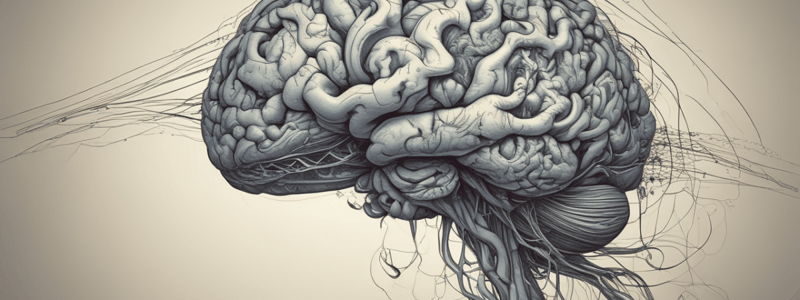Podcast
Questions and Answers
What is the primary characteristic of neurodegenerative diseases?
What is the primary characteristic of neurodegenerative diseases?
- Gradual improvement of neuronal function with age
- Progressive loss of neurons, typically affecting groups of neurons with functional relationships (correct)
- Progressive loss of neurons in adjacent groups
- Accumulation of protein aggregates in specific brain regions
What is the morphologic hallmark of neurodegenerative diseases?
What is the morphologic hallmark of neurodegenerative diseases?
- Inflammation of neuronal tissue
- Accumulation of protein aggregates (correct)
- Demylination of neuronal axons
- Fibrosis of neuronal tissue
What is the basis for protein aggregation in Huntington disease?
What is the basis for protein aggregation in Huntington disease?
- Environmental toxins
- Directly related to an intrinsic feature of a mutated protein (correct)
- Intrinsic feature of a peptide derived from a larger precursor protein
- An unexplained alteration of a normal cellular protein
What is the most common cause of dementia in older adults?
What is the most common cause of dementia in older adults?
At what age do patients with Alzheimer disease typically become symptomatic?
At what age do patients with Alzheimer disease typically become symptomatic?
What is the typical duration of progressive disability in Alzheimer disease?
What is the typical duration of progressive disability in Alzheimer disease?
What is the primary mechanism by which alterations in tau phosphorylation contribute to cognitive impairment in Alzheimer disease?
What is the primary mechanism by which alterations in tau phosphorylation contribute to cognitive impairment in Alzheimer disease?
Which of the following microscopic findings in Alzheimer disease is characterized by focal, spherical collections of dilated, tortuous, neuritic processes?
Which of the following microscopic findings in Alzheimer disease is characterized by focal, spherical collections of dilated, tortuous, neuritic processes?
What is the primary association of a large burden of plaques and tangles in Alzheimer disease?
What is the primary association of a large burden of plaques and tangles in Alzheimer disease?
Which of the following biochemical markers is correlated with the degree of dementia in Alzheimer disease?
Which of the following biochemical markers is correlated with the degree of dementia in Alzheimer disease?
What is the characteristic staining pattern of neurofibrillary tangles in Alzheimer disease?
What is the characteristic staining pattern of neurofibrillary tangles in Alzheimer disease?
Which of the following structures is involved early in the course of Alzheimer disease and is usually severely atrophied in the later stages?
Which of the following structures is involved early in the course of Alzheimer disease and is usually severely atrophied in the later stages?
What is the primary distinguishing feature of Frontotemporal Lobar Degenerations (FTLDS) from Alzheimer disease?
What is the primary distinguishing feature of Frontotemporal Lobar Degenerations (FTLDS) from Alzheimer disease?
Which of the following is a characteristic of the final stages of Alzheimer disease?
Which of the following is a characteristic of the final stages of Alzheimer disease?
What is the underlying morphology of Pick disease?
What is the underlying morphology of Pick disease?
What is the frequency of Frontotemporal Lobar Degenerations (FTLDS) compared to Alzheimer disease in individuals under the age of 65?
What is the frequency of Frontotemporal Lobar Degenerations (FTLDS) compared to Alzheimer disease in individuals under the age of 65?
Which of the following is NOT a characteristic of Frontotemporal Lobar Degenerations (FTLDS)?
Which of the following is NOT a characteristic of Frontotemporal Lobar Degenerations (FTLDS)?
What is the primary difference in microscopical morphology between Alzheimer disease and Frontotemporal Lobar Degenerations (FTLDS)?
What is the primary difference in microscopical morphology between Alzheimer disease and Frontotemporal Lobar Degenerations (FTLDS)?
What is the characteristic of the inclusions found in Pick cells?
What is the characteristic of the inclusions found in Pick cells?
Which of the following is a hallmark of Parkinson's disease?
Which of the following is a hallmark of Parkinson's disease?
What is the characteristic of neuronal loss in Parkinson's disease?
What is the characteristic of neuronal loss in Parkinson's disease?
Which of the following is a characteristic of dementia with Lewy bodies?
Which of the following is a characteristic of dementia with Lewy bodies?
What is the characteristic of Lewy neurites?
What is the characteristic of Lewy neurites?
What is the characteristic of the substantia nigra in Parkinson's disease?
What is the characteristic of the substantia nigra in Parkinson's disease?
What is the characteristic movement disorder seen in Huntington disease?
What is the characteristic movement disorder seen in Huntington disease?
Which brain regions are involved in Huntington disease, apart from the striatum?
Which brain regions are involved in Huntington disease, apart from the striatum?
What is the range of CAG repeats in the gene coding for huntingtin protein in Huntington disease?
What is the range of CAG repeats in the gene coding for huntingtin protein in Huntington disease?
What is the significance of the term 'autosomal dominant' in Huntington disease?
What is the significance of the term 'autosomal dominant' in Huntington disease?
What is the characteristic pathology seen in the striatum in Huntington disease?
What is the characteristic pathology seen in the striatum in Huntington disease?
What is the clinical manifestation of Huntington disease apart from chorea?
What is the clinical manifestation of Huntington disease apart from chorea?
Study Notes
Neurodegenerative Diseases
- Characterized by progressive neuronal loss involving specific neuronal circuits and brain regions
- Associated with accumulation of abnormal protein aggregates, typically in the form of cellular inclusions
- Clinical phenotype reflects the patterns of brain involvement more than the type of inclusions
Pick's Disease
- Microscopically: swelling neurons (Pick cells) with cytoplasmic, round to oval, filamentous inclusions (Pick bodies)
- Weakly basophilic but stain strongly with silver methods and contain 3R tau
Parkinson's Disease (PD)
- A neurodegenerative disease marked by a prominent hypokinetic movement disorder
- Caused by loss of dopaminergic neurons from the substantia nigra
- Presumptive diagnosis based on the presence of the central triad of parkinsonism—tremor, rigidity, and bradykinesia—in the absence of a toxic or other known underlying etiology
- Macroscopically: pallor of the substantia nigra
- Microscopically: Lewy bodies and areas of neuronal loss with gliosis
Dementia with Lewy Bodies
- Dementia developed at least one year prior to the onset of parkinsonism
- Microscopically: cortical Lewy bodies similar to classical Lewy bodies but seen in the cortex
Huntington's Disease (HD)
- An autosomal dominant disease characterized by progressive movement disorders and dementia
- Caused by degeneration of striatal neurons
- Mutation in gene coding for huntingtin protein on chromosome 4: 36–86 CAG repeats
- Clinical manifestation: chorea, psychiatric and cognitive symptoms, and cachexia
- Macroscopic: variable cerebral atrophy, depending on the stage of disease, with atrophy of striatum (caudate nucleus and putamen)
- Microscopic: neuronal loss and gliosis in striatum, with globus pallidus, substantia nigra, cerebral neocortex, entorhinal cortex, and hypothalamus also involved
Alzheimer's Disease (AD)
- The most common cause of dementia in older adults
- Typically becomes symptomatic after 50 years of age, with incidence increasing with age
- Causes alterations in tau phosphorylation, along with oxidative injury to neurons
- Basis for cognitive impairment: presence of a large burden of plaques and tangles, with biochemical markers including loss of choline acetyltransferase and amyloid burden
- Macroscopic: cortical atrophy most pronounced in the frontal, temporal, and parietal lobes, with secondary ventricular enlargement
- Microscopic: neuritic (senile) plaques and neurofibrillary tangles, with progressive neuronal loss and reactive gliosis
Frontotemporal Lobar Degenerations (FTLDs)
- One of the more common causes of early onset dementia, occurring at the same frequency as Alzheimer disease in those under the age of 65 years
- Distinguished from AD by the fact that alterations in personality, behavior, and language (aphasias) precede memory loss
- FTLD is associated with cellular inclusions of specific proteins
- Macroscopically: atrophy of frontal and temporal lobes to variable extent and severity
- Microscopically: neuronal loss, gliosis, and the presence of tau-containing neurofibrillary tangles
- Pick disease: a subtype of FTLD-tau, characterized by severe circumscribed asymmetric “knife-edge” atrophy of frontal and temporal lobes with conspicuous sparing of the posterior two thirds of the superior temporal gyrus and only rare involvement of either the parietal or occipital lobe
Studying That Suits You
Use AI to generate personalized quizzes and flashcards to suit your learning preferences.
Related Documents
Description
Test your knowledge of neurodegenerative diseases, including their characteristics, classification, and common pathologic processes. This quiz covers the progressive loss of neurons, genetic and molecular studies, and more. Learn about the features shared across various neurodegenerative diseases.




